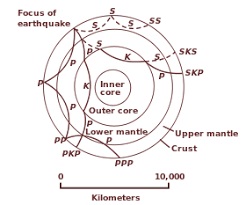|
|
| |
|
|
| |
|
|
|
|
| |
 |
| Seismic velocities
and boundaries in the interior of the Earth
sampled by seismic waves. |
Seismology
Seismology ( /saɪzˈmɒlədʒi/; from Ancient Greek σεισμός
(seismós) meaning "earthquake" and -λογία (-logía)
meaning "study of") is the scientific study of
earthquakes and the propagation of elastic waves through
the Earth or through other planet-like bodies. The field
also includes studies of earthquake environmental
effects such as tsunamis as well as diverse seismic
sources such as volcanic, tectonic, glacial, fluvial,
oceanic, atmospheric, and artificial processes such as
explosions. A related field that uses geology to infer
information regarding past earthquakes is
paleoseismology. A recording of Earth motion as a
function of time is called a seismogram. A seismologist
is a scientist who does research in seismology.
Earthquake prediction
Forecasting a probable timing, location, magnitude and
other important features of a forthcoming seismic event
is called earthquake prediction. Various attempts have
been made by seismologists and others to create
effective systems for precise earthquake predictions,
including the VAN method. Most seismologists do not
believe that a system to provide timely warnings for
individual earthquakes has yet been developed, and many
believe that such a system would be unlikely to give
useful warning of impending seismic events. However,
more general forecasts routinely predict seismic hazard.
Such forecasts estimate the probability of an earthquake
of a particular size affecting a particular location
within a particular time-span, and they are routinely
used in earthquake engineering. |
|
Seismology is done by seismologists and geophysicists
using devices to pick up the vibrations called
geophones, hydrophones or seismometers.
Seismology can either be passive, just listening to
vibrations caused by earthquakes and volcanic activity,
or active, using small explosive charges to send
vibrations into the ground. |
|
Seismic detectors come in two types, one which measures
up and down vibrations, and one which measures side to
side vibrations. Both types use and arrangement of a
magnet and a coil of wire which will convert the
vibrations into an electrical signal which can be stored
in a computer for analysis.
Seismologists can find the location of earthquakes by
plotting received vibrations on a map. They can also
pick up underground nuclear tests, and this is what many
of the seismic recording stations were set up for. |
|
|
They can also examine the crust in a seismic survey to
try and find information about layers of rock, locate
oil or gas fields and to get information about the
internal structure of volcanos. |
|
|
|
|
|
|
|
|
|
|
|
|
|
|
|
|
|
|
Search Fun Easy English |
|
|
|
|
|
|
|
|
|
|
|
|
|
|
|
About
Contact
Copyright
Resources
Site Map |